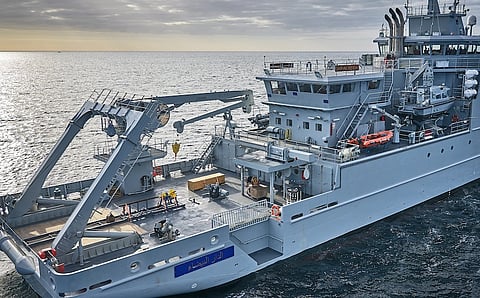

Over the past half century research and training vessels have become very specialised and, mostly, very expensive. Almost invariably they are owned and operated by governments.
Training vessels, generally, seem to be gradually fading away. For most of last century, any self-respecting maritime country, and many others, possessed at least one sail training ship. Regattas, "tall ships" races, and other gatherings were organised for them world-wide. I well remember their visits to Australia for the bi-centenary celebrations of 1988. Very impressive.
Since then, though, while there is still some activity in Europe and the wider North Atlantic, it has steadily decreased. That is sad.
Training, increasingly, seems to be done "on the job". That, probably, is a realistic approach in most countries but big crew-supplying nations like the Philippines and Indonesia might well benefit from having a sail training ship that actually goes to sea.
There are, of course, many, usually small, naval training vessels and some maritime academies and colleges possess vessels but, every year, it seems, there are fewer. We see very few on this website. That is disappointing. I am convinced that more of them, operated properly, would lead to higher standards of seamanship and, therefore, safety. The small specialised vessels are useful, as far as they go, but larger ones offering more general maritime training would provide greater benefits.
Research vessels, on the other hand, are flourishing almost globally. As you will learn from this week's feature, they are being launched thick and fast. They range from small inshore craft to large, powerful, long-range icebreakers. Some of them are very innovative and exciting craft.
This week's offering ranges from a very impressive, electric powered inshore hydrography research boat from France's Alumarine to a very large research icebreaker for China's Chinare. The Xue Long 2 is 123 metres in length and has a deadweight of 4,500 tonnes along with a range of 20,000 nautical miles.
The British Cammell Laird-built RRS Sir David Attenborough is nearing delivery after an interminably long gestation period. It, too, is large at 129 metres LOA, and has all the "bells and whistles". Could the Brits not, however, have dug up a more appropriate and historic maritime explorer to name it after than a television naturalist? There are dozens of them. How about William Dampier, an explorer with plenty of guile and spirit and, arguably, better known in his day than Attenborough is now? I preferred the mock name that was first mooted for the ship: Boaty McBoatface.
Canada's Vancouver based SeaSpan Shipyard has produced three largish, 63-metre, Oceanographic Science vessels. Reviewed here is the fisheries science vessel Captain Jacques Cartier, named appropriately after a famous explorer.
Damen's Constantia yard in Romania has almost finished a magnificent new icebreaker for Australia to replace the well worn, thirty-two-year-old, locally built Aurora Borealis that has served the country so well. It is expected to be delivered in January 2021.
Research and training vessels are an interesting sector of the wider maritime world. Because they tend to be owned by governments, little expense is spared on them. That helps to encourage, if not ensure, innovation. Plenty of that will be highlighted this week.
– "The decision for the refit was…the result of a long-term gradual change in focus by the [Swedish Coastguard] towards environmental monitoring and protection."
– by Nelson Dela Cruz, Baird Maritime's Philippines correspondent
– "The National Marine Fisheries Service was keen on finding out how much live tuna bait there was in Kapingamarangi and to pass on our findings to the local fishermen."
– by Bob Iversen, retired Hawaii fishery biologist and a former officer in the US Navy
– "…if anyone ever gets around to revising deck cadet training to make it suitable for the modern era, I hope they will look to the past and include training modules."
– by Alan Loynd, marine consultant and former general manager of the Hong Kong Salvage and Towage company
Remember to come back every day to see the latest news, opinion and vessel reviews!
Any news or views about the marine research and training industry? Send it through to editor@baird.com.au ASAP (between now and September 11), so we can add it to this current edition of Research and Training Week!
We are after:
